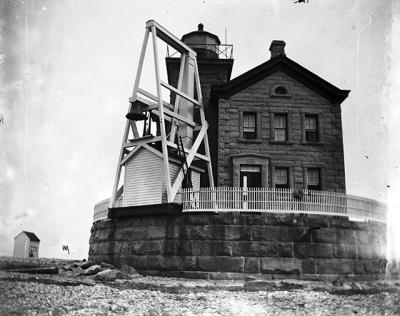Green Light for Historic Lighthouse

The Cedar Point Lighthouse, a beacon that stood sentinel for the busy port of Sag Harbor for some 100 years, will be restored after falling into a perilous state.
On Monday at 11 a.m., Suffolk County Legislator Bridget Fleming will join State Assemblyman Fred W. Thiele Jr., Suffolk County Executive Steve Bellone, and County Legislator Kara Hahn at the end of Sag Harbor’s Long Wharf to announce the appointment of the Lee H. Skolnick Architecture and Design Partnership to renovate the roof and exterior of the building, which stands facing Shelter Island between Gardiner’s Bay and Northwest Harbor. The County Legislature has approved $500,000 for work.
“We’re just thrilled to be part of this important and historic project,” said Lee Skolnick, founding partner of the eponymous firm. Mr. Skolnick’s company has worked on other public and landmark properties on the East End, including the East Hampton Library, Guild Hall, the headquarters of the East Hampton Ladies Village Improvement Society, and the Children’s Museum of the East End. “This is the crowning jewel,” Mr. Skolnick said, “with so much historical impact.”
Lighthouses have always captured the imagination, harking back to an era when nautical travel reigned and life moved at a slower speed. The purpose of the sturdy Cedar Point fortress was to guide ships, and in particular whaling vessels, into Northwest Harbor and the thriving whaling port of Sag Harbor.
The Cedar Point Lighthouse has its own romanticized lore. The land on which the lighthouse sits was once a two-acre island, home to small bushes and trees. The first lighthouse there was constructed in 1839 as a wooden, one-and-a-half-story keeper’s dwelling with a small tower centered on its pitched roof and a cast-iron beacon in a lantern room. By 1858 the structure was dilapidated and struggling to support the heavy lantern and in 1867 Congress approved $25,000 to rebuild it.
The resulting lighthouse, completed in 1868, was constructed with granite blocks atop a circular granite pier. The L-shaped structure with a new square tower was of the Victorian-Gothic architectural style, similar to other lighthouses of the time. The lens from the 1839 lighthouse was placed 44 feet above the water in the new tower. In 1882, a machine-operated foghorn was added to the station. As with many light stations, the keeper and his family were important members of the community. One such overseer was peg-legged Charles Mulford who was appointed keeper in 1897. The Civil War veteran was famous for buying up every wooden leg available. It is reported that after a 1974 fire at the lighthouse, firefighters found a storeroom filled with wooden legs that had only partially survived the fire.
The lighthouse was decommissioned in 1934 and its beacon replaced by an automatic light. It was purchased in 1937 by Phelan Beale, an uncle of Jacqueline Kennedy, who at the time owned 4,000 nearby acres as a game preserve. Later, it was used as a summer home, with murals on the dining room walls and oak paneling, for Isabel P. Bradley of Darien, Conn.
Over the years, erosion caused much of the island on which the lighthouse stood to shrink, and the Hurricane of 1938 filled the 200-yard gap between the island and the shore.
Advances in satellite marine navigation reduced the need for light beacons across the world, and in 1967 Suffolk County purchased the Cedar Point Lighthouse. Vandalism and weather took its toll and eventually it was gutted by fire, in 1974. It is now on the National Register of Historic Places.
Mr. Skolnick and his business partner, Paul Alter, submitted their firm’s proposal to the county last fall. With their appointment now official, he said the first phase would be to stabilize the structure, which will include repairs on the roof and the plinth on which it stands. The windows are either bricked-up, he said, or covered with leaves and debris. “We need to repair them to keep water and animals out and stop it from deteriorating any further,” he said.
The architect referred to the project as “a labor of love,” which can sometimes be euphemistic for a not-for-profit venture. “Well, we’ll see how far $500,000 will take us,” he said smiling, before adding, “but we’re prepared to go as far as necessary to do it well.”
In 2014, the four-and-a-half-ton lantern room canopy was hoisted off the lighthouse and barged to the Sag Harbor Yacht Yard on Bay Street, where it is being restored. This will be the site of Monday’s press conference, when state and county officials are expected to reveal plans to turn the approximately 900-square-foot keeper’s dwelling into a bed-and-breakfast.
While Mr. Skolnick said the firm would not touch the interior during the first phase of the project, he said, “We’ll be the first to submit a proposal when that time comes.”
Legislator Fleming said it was a “very special project for a real landmark that is part of our area’s maritime history.” She said she was grateful to her colleagues for recognizing the significance of an iconic structure in local waters.
Mr. Skolnick said he was uncertain how long the initial phase of the restoration would take, but he stressed that it is a job they will not rush. “Public projects are not for the impatient,” he said
